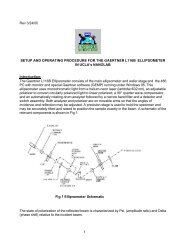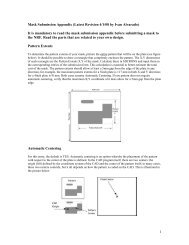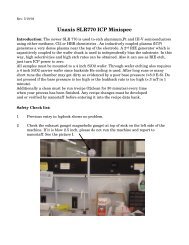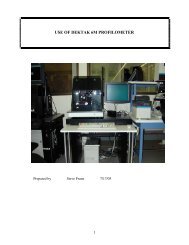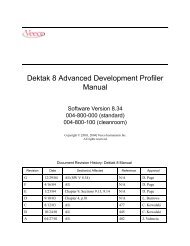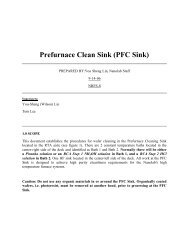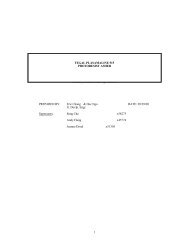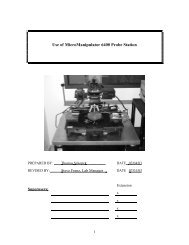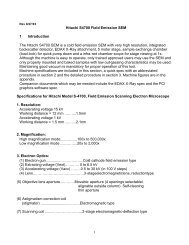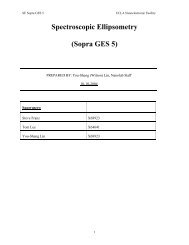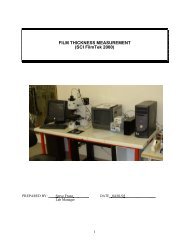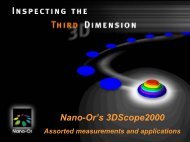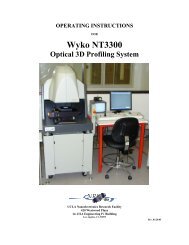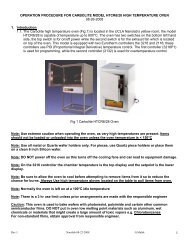Tystar Oxidation & Anneal Furnace Operation - Login | Nanolab, UCLA
Tystar Oxidation & Anneal Furnace Operation - Login | Nanolab, UCLA
Tystar Oxidation & Anneal Furnace Operation - Login | Nanolab, UCLA
You also want an ePaper? Increase the reach of your titles
YUMPU automatically turns print PDFs into web optimized ePapers that Google loves.
1.0 INTRODUCTION:<br />
This document covers the operation of <strong>Tystar</strong>'s oxidation and anneal tube (Tube 5) located in<br />
<strong>UCLA</strong>'s Nanoelectronics Research Facility. It sits in the left side bank of 4 tubes each of which<br />
has its own heaters, and closed-loop temperature control, associated quartzware and load<br />
system, and each of which has its own gas flow control system. Tube 5 is a general purpose<br />
tube for anneals, drives and oxidations and does not require the same level of cleanliness as<br />
Tube 1. Tube 5 is also of the older style which uses a process controller rather than tube<br />
computer. The tube numbering and process assignments are as follows:<br />
Right side bank<br />
Topmost tube Tube 1 <strong>Anneal</strong>, Dry & Wet <strong>Oxidation</strong>- Very clean and<br />
lightly doped samples only<br />
2nd Tube from top Tube 2 Silicon Nitride (standard or low stress)<br />
3rd Tube from top Tube 3 Polysilicon (doped or undoped)<br />
Bottom tube Tube 4 Low Temp Oxide (LTO-doped or undoped)<br />
Left Side Bank<br />
Topmost tube Tube 5 <strong>Anneal</strong>, Drive and <strong>Oxidation</strong> for<br />
heavy doped samples<br />
2 nd Tube from top Tube 6 Currently not used<br />
3 rd Tube from top Tube 7 Currently not used<br />
Bottom Tube Tube 8 N2 sinter or Vacuum anneal (350-600C)<br />
This system uses hazardous gases and high temperatures and therefore could cause serious<br />
injury if any action is attempted without THOROUGHLY understanding the system. Refer to<br />
the appendix (LPCVD <strong>Furnace</strong> Shut Down and Emergency Procedures) for safety related<br />
information.<br />
NOTE: While tubes 2,3 and 4 are LPCVD furnaces utilizing vacuum and toxic gases, tube 1<br />
and 5 are atmospheric furnaces that do NOT use a pump or any kind of vacuum. They also do<br />
NOT use any toxic gases and are therefore simpler systems to run than the other tubes. Tube<br />
1 and 5 do use hydrogen and oxygen which are very flammable and potentially explosive<br />
gases, however.<br />
Successful deposition requires extreme cleanliness for anything that goes directly into the tube<br />
or anything that touches anything which goes into the tube. Therefore:<br />
• NEVER touch boats or wafer with your hands even if you are wearing gloves.<br />
Use ONLY the appropriate boat holder. Boat Holder must be clean also.<br />
• Use ONLY clean tweezers or vacuum wand dedicated for that tube. Clean these<br />
implements often using alcohol, DI water and clean wipes.<br />
• ALWAYS clean wafers using either piranah or RCA type clean right before loading<br />
them into the tube. (NOTE: For the LTO tube ONLY a substitute clean for metallized<br />
wafers may be used, otherwise the metal may be attacked.) Wafers must be Clean<br />
and Dry. Use spin rinse dryer whenever possible. Never load a contaminated wafer<br />
or boat into the tube as this will contaminate the tube as well.<br />
• Wafers and boats coming out of the tube are extremely hot. Do NOT set them on<br />
clean wipes, vinyl gloves or anything else which will melt. Set hot items on clean<br />
2



